In the future, Cardano will achieve complete on-chain governance and self-sustainability through the Chang hard fork, ushering in the Voltaire era.
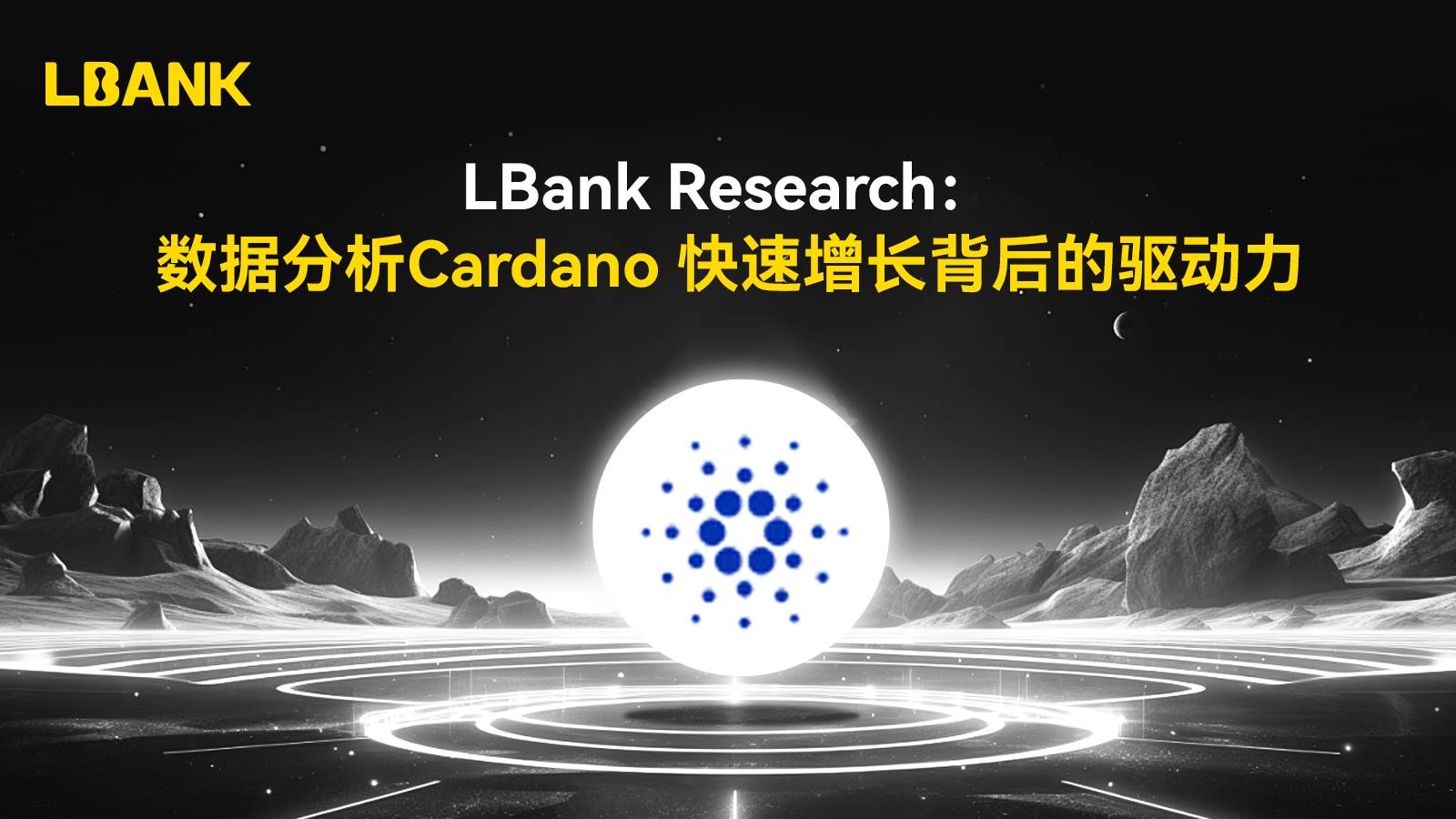
Introduction
Since its launch in 2017, Cardano (ADA) has grown into a PoS network aimed at pushing the limits of blockchain technology. As a platform dedicated to security, scalability, and functionality, Cardano is not just a cryptocurrency but provides a robust environment for developers and users to build decentralized applications and systems. Through close collaboration with organizations such as Input Output Global (IOG), the Cardano Foundation, and EMURGO, Cardano has taken significant steps on its roadmap, entering the competition in areas like smart contracts, DeFi, and NFTs.
This article will take you deep into Cardano's latest developments, key data, and network features, exploring the use cases of ADA and its role in the broader crypto economy. Whether you are a developer, investor, or blockchain technology enthusiast, this article will provide you with comprehensive insights into the Cardano ecosystem, from governance innovations to financial health, and the dynamic growth of DeFi, looking forward to Cardano's ultimate goal—the future of the Voltaire era.
Overview of Cardano
Cardano is a layer one PoS network launched in 2017. Its goal is to provide security, scalability, and functionality for decentralized applications and systems built on its network. In addition to support from developers, node operators, and the community of projects, Cardano is also backed by organizations such as Input Output Global (IOG), the Cardano Foundation, and EMURGO. These organizations collectively drive the development, adoption, and fundraising of the network, leading Cardano toward the final phase of its roadmap—the Voltaire era.
Compared to other smart contract networks, Cardano adopts a unique approach to development. The Ouroboros consensus mechanism allows for stake delegation, while the extended eUTXO accounting model facilitates the transfer of native tokens, scalability, and decentralization.
With a loyal group of users and developers, Cardano has proven its resilience. After the Alonzo hard fork in 2021, which enabled smart contract support, Cardano began to compete in more traditional crypto markets like DeFi and NFTs.
Key Data
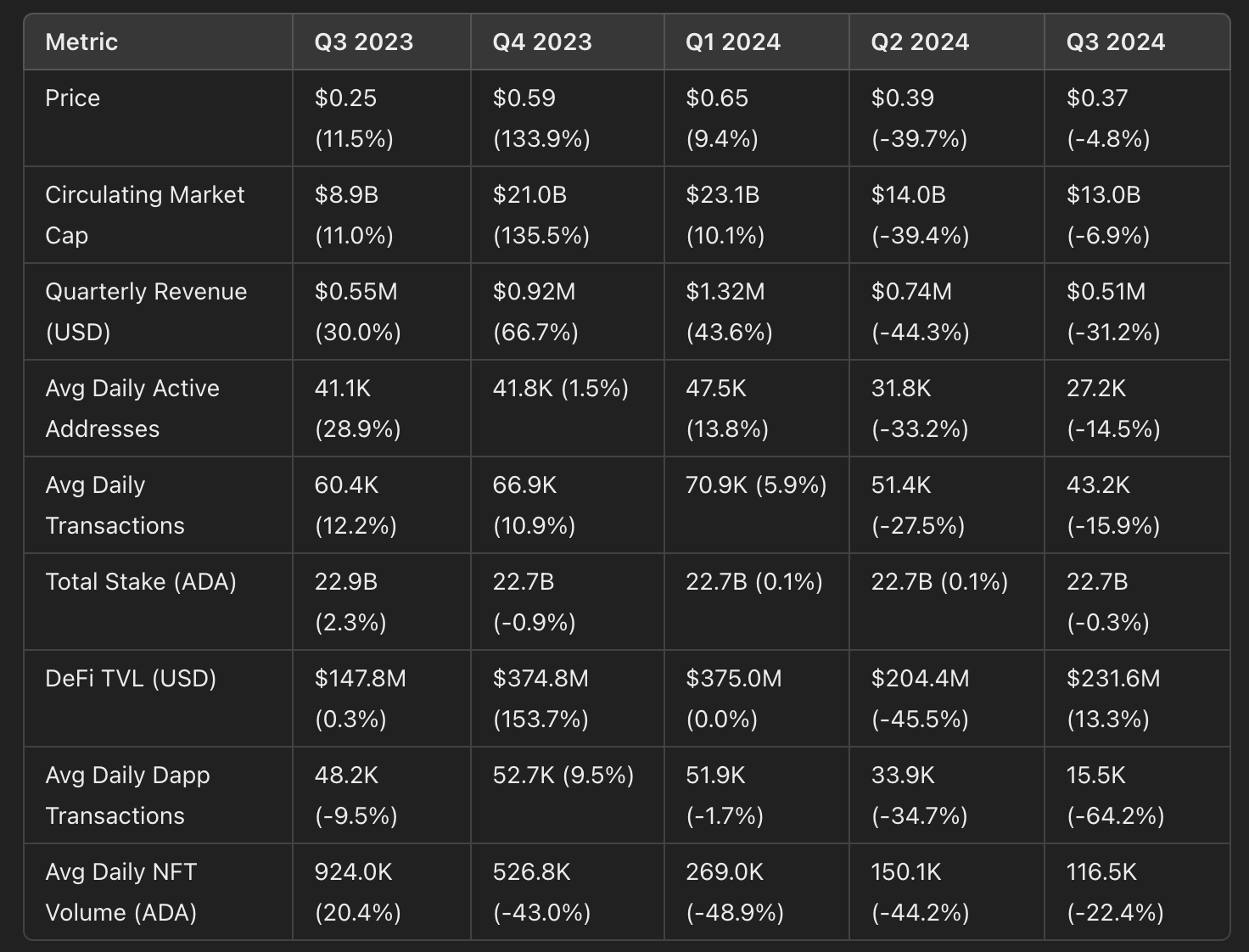
Profit Data
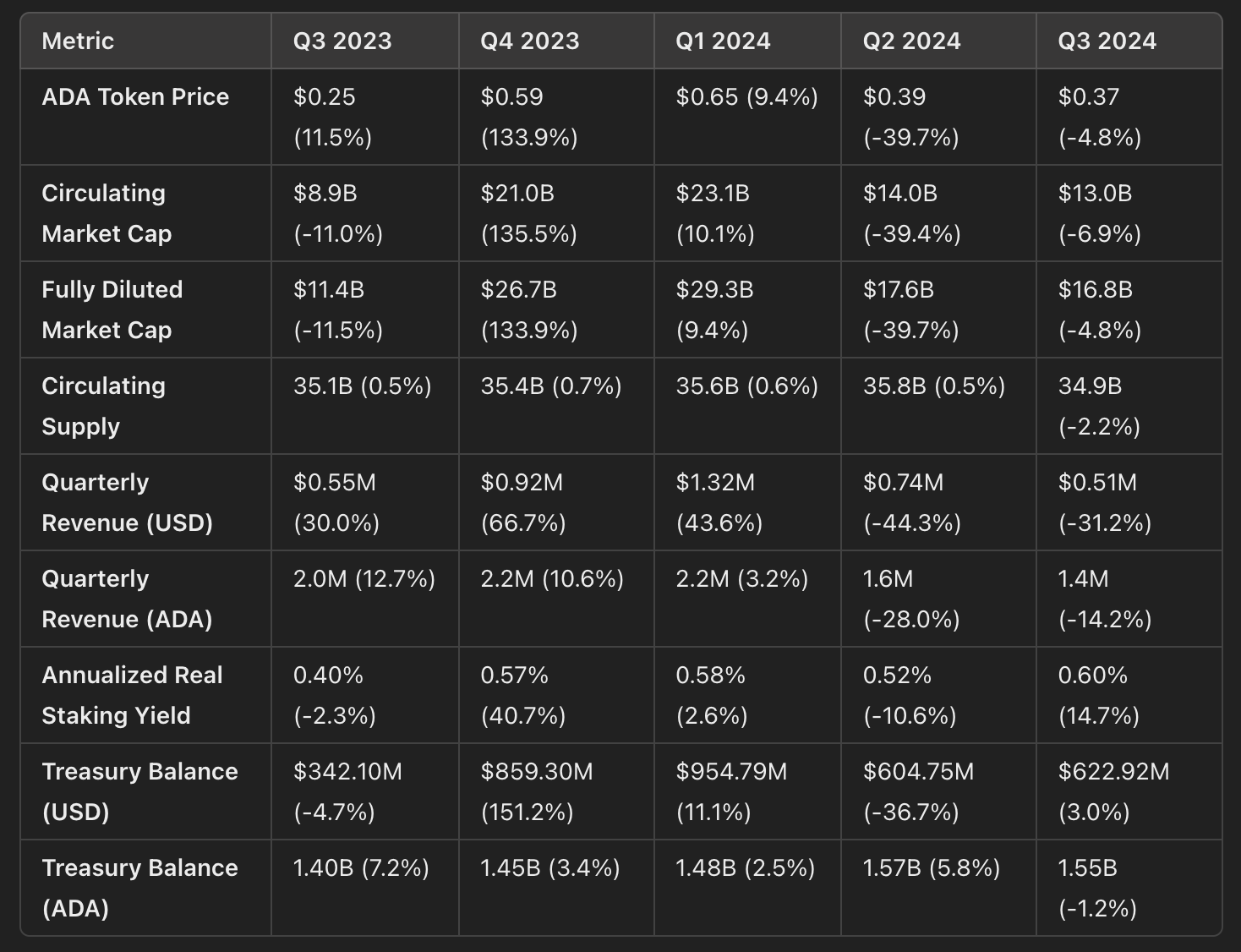
ADA is the native asset of Cardano, serving as the primary medium of exchange for network transactions. It has four main network-level use cases:
(i) Settlement of Network Transaction Fees: ADA is used to pay for transaction fees on the Cardano network.
(ii) Registering Stake Pools: Users can use ADA to register a stake pool, participate in network consensus, and become stake pool operators (SPO).
(iii) Staking: Whether as a stake pool operator or a delegator, staking ADA helps secure the network and earn token rewards.
(iv) Rewarding Voters and Funding Projects: In Project Catalyst, ADA is used to reward voters and fund projects.
The maximum supply of ADA is 45 billion, and its circulating supply will experience inflation until it reaches this maximum. At the end of each five-day epoch, 0.3% of the ADA reserves (un-circulated ADA) will be allocated to SPOs as rewards. This "inflation" approaches zero as reserves are consumed and circulating supply nears 45 billion.
The annualized real staking yield considers value dilution due to inflation. In the third quarter, the annualized real staking yield was 0.6%, but this may vary across different stake pools.
In the third quarter, the price of ADA decreased by 4.8%, reaching $0.37. Consequently, ADA's total market capitalization fell by 6.9% to $13 billion, with the slight difference in total market capitalization due to a 2.2% decrease in circulating supply. Due to the price drop, ADA's circulating market capitalization ranking fell from 10th to 11th place in the third quarter.
On Cardano, every transaction requires a network transaction fee, which is used to process transactions and pay for storage costs. The fee calculation includes a minimum fee plus a variable fee based on transaction size. Revenue (in USD) decreased by 31.2% to $510,000, while revenue (in ADA) decreased by 14.2% to 1.4 million ADA. This difference was due to the price drop of ADA throughout the quarter.
Currently, 20% of Cardano's transaction fees go into the treasury. The treasury balance (in ADA) decreased by 1.2% to 1.55 billion ADA, but the treasury's dollar value increased by 3% to $622.92 million.
Daily Active Data
In the third quarter, Cardano's average daily transaction volume decreased by 15.9% to 43,200, while the average daily active addresses (DAAs) also fell by 14.5% to 27,200. Cardano's average transaction fee remained unchanged at $0.13. However, the average transaction fee (in ADA) decreased by 17.9% to 0.54.
The ratio of transactions to active addresses (txs/DAAs) decreased by 1.7% to 1.59. An increase in this ratio typically indicates that activity is more evenly distributed among users; conversely, a decrease in the ratio suggests an increase in "heavy users."
The total staked amount (ADA) and the staking rate of ADA decreased by 0.3% and 4.1%, respectively. Due to the decline in ADA's price, the total staked amount (in USD) decreased by 5.1% to $8.5 billion. The total staked amount (in USD) represents the economic security of the network.
Governance and Forks
In April 2024, Cardano announced the Chang hard fork, a network upgrade conducted in two phases aimed at achieving on-chain governance and completing the core objectives of Cardano's final roadmap phase. Voltaire moves toward Cardano's self-sustainability through on-chain voting and off-chain mechanisms and organizations like the member-based organization Intersect.
- Phase One: Begins after the Chang hard fork launches on September 1, 2024. This phase initiates a technical guidance period, setting the stage for decentralized voting and governance actions.
- Temporary Cardano Constitution: Used to fill the gap until a true constitution is iterated through the Cardano Constitution Workshop and approved at the Cardano Constitution Conference in Buenos Aires, Argentina, in December 2024.
- Interim Constitution Committee (ICC): Composed of seven members, three of whom are elected by vote. In the first phase, the ICC has veto power over certain on-chain governance actions.
- Phase Two: Will see Cardano's on-chain governance fully online as the Cardano Constitution is completed and approved. This phase will enable ADA token holders to guide technical changes and treasury withdrawals, partly by introducing new user roles, delegating representatives. ADA token holders will be able to delegate governance power to DReps and SPOs, who can vote on governance proposals on their behalf.
- Registering as a DRep: Is now open, requiring a one-time deposit of 500 ADA.
After the completion of Phase Two, DReps, SPOs, and the Constitution Committee will manage all areas of the network through on-chain voting and treasury systems based on CIP-1694. This will transfer responsibility from IOG, the Cardano Foundation, and EMURGO, which historically held all seven governance (genesis) keys. Governable actions include matters related to the Constitution Committee, parameter changes, constitutional updates, hard fork launches, protocol parameter changes, and treasury withdrawals.
Intersect & SanchoNet
Testing related to CIP-1694 continues on SanchoNet, a test network launched in the third quarter of 2023, designed as a sandbox to test and build the processes and tools for Cardano's on-chain governance. Developers utilize this testnet to launch new infrastructure (such as wallets and voting browsers), and SPOs can test voting and proposals, with details about DReps also discussed here.
SanchoNet and the broader Voltaire promotion efforts are led by Intersect, a member-based organization serving the Cardano ecosystem, combining the strengths of community members, SPOs, and project teams. Intersect was established to gather ADA token holders around a common vision for a more transparent, collaborative, and innovative Cardano ecosystem.
Intersect maintains over 60 code repositories, including the complete Cardano Haskell code, and promotes Cardano's open-source approach through various standing committees and working groups. Additionally, Intersect is working to create an open product roadmap, annual budgeting process, and has been operating a funding program that rewards projects related to governance, such as education and DRep platforms.
DeFi
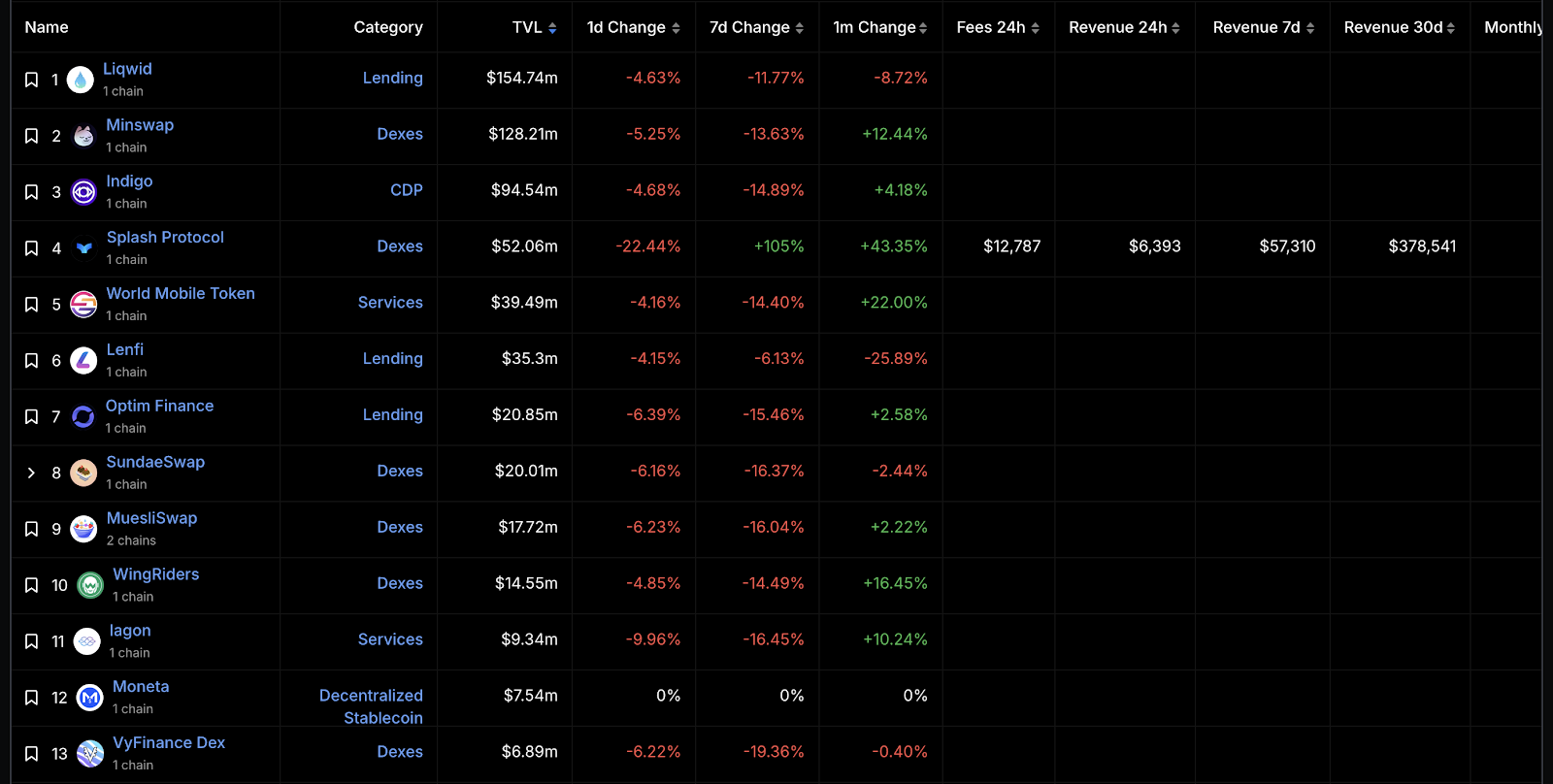
In the third quarter, Cardano's total value locked (TVL, in USD) in DeFi grew by 13.3% to $231.6 million, while the DeFi diversity score increased by 12.5% to 9. There were many changes in the TVL of various protocols in the third quarter.
- Minswap's TVL slightly increased by 4.4% to $58.6 million.
- Liqwid's TVL surged by 77.2% to $47.1 million, surpassing Indigo, whose TVL decreased by 19.7% to $38.4 million.
- Smaller protocols like Splash Protocol and SundaeSwap grew by 76% and 26%, reaching $16.9 million and $16 million, respectively.
Indigo is a synthetic asset issuer that provides iUSD, iBTC, and iETH. One week after the end of the third quarter, Indigo completed its upgrade to V2.1. This upgrade introduced algorithmic interest rates, sharing interest distributions between the treasury and INDY stakers, along with several other improvements.
Splash is a decentralized exchange (DEX) launched in July, which previously raised 17.2 million ADA through a SPLASH token sale in May. Splash is also committed to developing snek.fun, a protocol similar to pump.fun on Solana, allowing users to easily launch and trade tokens. The application was launched in September and witnessed the creation of over 2,230 tokens and a trading volume of 4.5 million ADA on its first day.
SundaeSwap continued the momentum from the second quarter by launching the V3 upgrade, which introduced a dynamic fee model and increased trading capacity. At launch, it included a 90-day fee waiver, which expired in August, followed by a proposal to increase fees in September. SundaeSwap's revenue is distributed to SUNDAE token holders, the SundaeSwap treasury, Sundae Labs, and others.
ADA Token Unlocking
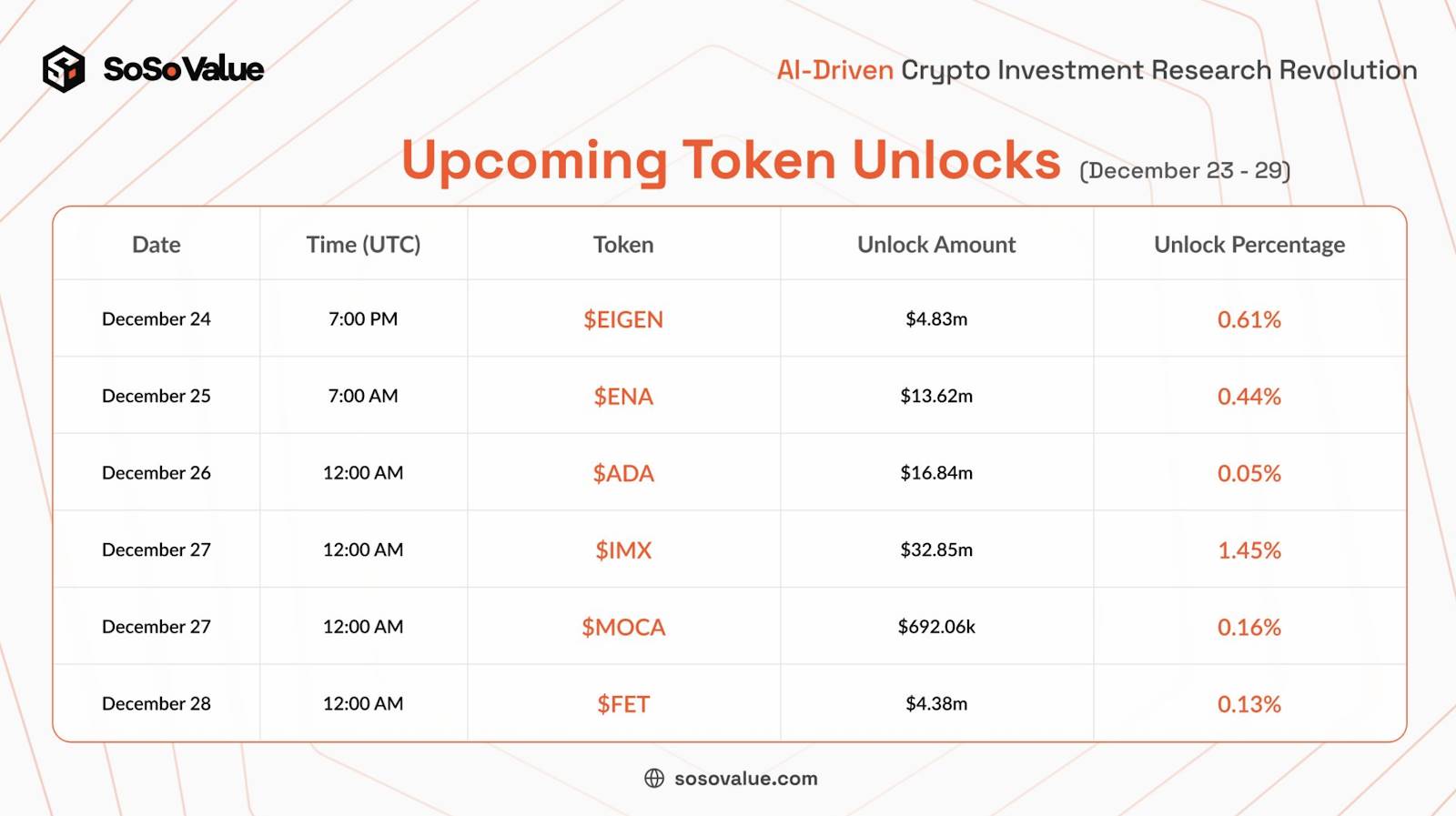
Recently, Cardano (ADA) will unlock tokens this week. Approximately 16.84 million ADA tokens are expected to be unlocked, accounting for 0.05% of the current circulating supply.
Future Outlook
Cardano launched in 2017 as a layer one PoS network, aiming to provide a secure, scalable, and feature-rich platform to support decentralized applications and systems. With its unique Ouroboros consensus mechanism and extended eUTXO model, Cardano has demonstrated competitiveness in the fields of smart contracts, DeFi, and NFTs.
With the implementation of the Alonzo hard fork in 2021, which enabled smart contract support, Cardano entered a new phase of development. In the future, Cardano will achieve complete on-chain governance and self-sustainability through the Chang hard fork, ushering in the Voltaire era. By introducing new governance mechanisms and enhancing the diversity of the DeFi ecosystem and TVL growth, Cardano is expected to continue solidifying its position in the blockchain industry and drive further development of its ecosystem through ongoing technological innovation and community governance.
免责声明:本文章仅代表作者个人观点,不代表本平台的立场和观点。本文章仅供信息分享,不构成对任何人的任何投资建议。用户与作者之间的任何争议,与本平台无关。如网页中刊载的文章或图片涉及侵权,请提供相关的权利证明和身份证明发送邮件到support@aicoin.com,本平台相关工作人员将会进行核查。




